Making Lemonade
When life gives you lemons, make lemonade – or at least try to.
I know I keep talking about this (and I promise this will be the last time), but when your CTD breaks, and the backup CTD refuses to work properly, how do you collect water for a project based entirely on collecting seawater? And not just surface water, but water at depth. And you don’t even know if there is anything of interest to be collected at depth because the CTD package isn’t giving a profile of the temperature, salinity and fluorescence. This cruise has been a challenge not just for us, but for the technical support on the ship.
As you already know, we are using a bucket to collect surface water. We bought these in Punta Arenas the day that we were leaving port. Oceanographers should always have at least one clean plastic bucket with a sturdy metal handle. There are ones on the ship, but they often have oil or other chemical residues which will harm the organisms we are trying to study. We joke about using the bucket, but it’s not always easy to do – particularly in 30-40 knot winds and blowing snow. Getting the bucket down to the water without the wind taking it for a ride can be a challenge, and repeatedly hauling it up from a churning sea is a workout.
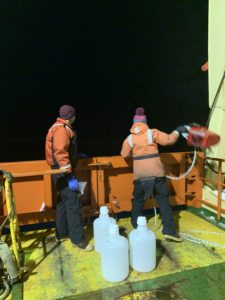
We have had company on deck on several occasions – birds! But only when it has snowed. We come out on deck and there can be up to 20-30 birds sitting around. Most of them are these lovely snow petrels, and there are sometimes 1-2 larger gulls. You’ll also find their footprints in the snow all over the ship. They aren’t terribly concerned about us, and I think they are using the ship as a resting spot from the wind. But I don’t really know why they would need it. If you are following our cruise track you’ll notice that we are almost always near land. (I’ll explain more about why in a future post.)
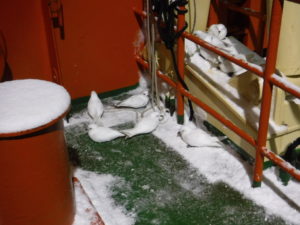
So, we’ve got surface water pretty well sorted out, but what about that deeper water? During the spring and summer a peak of fluorescence is observed at about 50-70 meters below the surface. We are interested in knowing whether that exists now, in the late fall, and at what depth it is located. We’d like to test for mixotrophs there as well, because the organisms may respond differently. We’ve been using an instrument called a PRR (Profiling Reflectance Radiometer, that’s Kevin and Wade getting ready to do a deployment) to measure the light quality through the water column, and Wade figured out a way to convert the data to estimate the fluorescence. This has given us a glimpse at a subsurface peak, but it’s only appeared twice (out of 5+ deployments) and it’s at 12-15 meters. It’s also not very big.
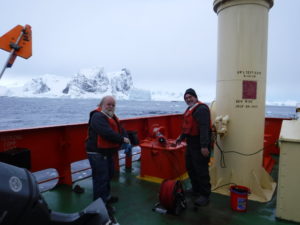
The electronic technician onboard managed to get fluorescence detection on the mini-CTD instrument package to work, so we have been using that as well to look at the water column. Again, not much evidence of a subsurface fluorescence peak. And perhaps this is not surprising as there have been several storms over the past two weeks which will mix the surface water column. Also, there has not been much bright sun, which may result in the photosynthetic organisms remaining closer to the surface in order to get what little light is available.
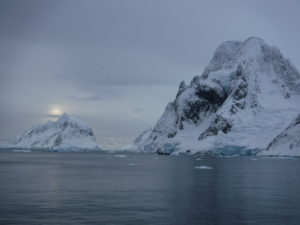
But how would we sample the peak even if it was there? Well, one of the marine technicians managed to modify the firing mechanism for a Niskin bottle from the large rosette (a 12 liter bottle – coincidentally, our bucket holds that same amount). He also made it possible to attach the bottle to the winch wire, and found a messenger (a heavy metal weight) that slides down the wire to trigger the closing mechanism. We first do a water column profile with the mini-CTD, then attach the modified Niskin bottle to the winch wire above the CTD (for weight). We can tell how deep it goes by ‘zeroing’ the winch wire with the bottle at the surface. We have collected subsurface water this way twice, although neither subsurface peak was very large.
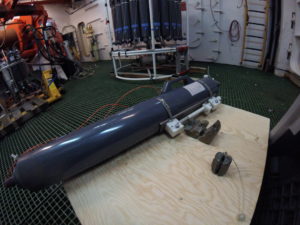
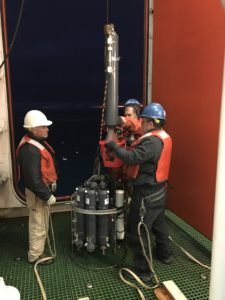
As I said before, it has taken a major combined effort to come up with a workable solution. It’s better than the alternative of no water and no idea of whether there is a fluorescence peak below the surface.